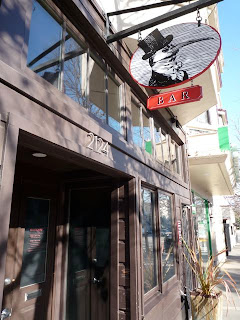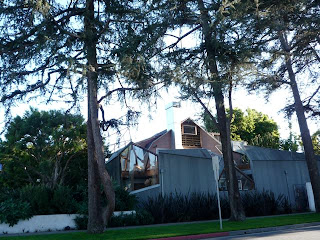Monday, January 31, 2011
Into the void
Posted by
jim and Mary
at
6:59 AM
![]()
![]()
Labels: ceramics, city gallery, labels
Saturday, January 29, 2011
-esque
Friday, January 28, 2011
Warning to artists
Posted by
jim and Mary
at
11:52 AM
![]()
![]()
Labels: advice to artists, art museum, dealer gallery
Taking to art in the movies
Any of you who are MTV followers might have seen a tribute to this sequence by the Utah-based Indie band Neon Trees for the track Animals off their Habits CD. In this tribute the masterpieces are generic modern, copycats of Rothko, Pollock, Stella and Ryman. As in the Batman sequence, the gassed gallery patrons hit the floor and the NTs slouch in to do the business. And this time it is a ‘Pollock’ that is saved from a wetting.
Finally, and rather weirdly, the art patrons rise up after the rampage now sporting 3D animal masks including a Hammond-like bird person (see for yourself).
Images: Top four images, left the Joker and his boys damage everything but the Bacon while Neon Trees spare the ‘Pollock’. Bottom four images, two times ‘Rothko’ (the generic art prop favourite), lookalike abstracts and a copycat Flavin.
Posted by
jim and Mary
at
6:55 AM
![]()
![]()
Labels: art in the movies
Thursday, January 27, 2011
That art is scrap
Photo opportunity
Images: top, postcard of Bluff signpost (we cheated and reproduced it in black and white). Bottom, Peter Peryer's photograph Bluff 1985
Posted by
jim and Mary
at
6:59 AM
![]()
![]()
Labels: photography
Wednesday, January 26, 2011
We have seen the future and it is virtual
Tuesday, January 25, 2011
He’s got game
Stainless reputation
Posted by
jim and Mary
at
6:57 AM
![]()
![]()
Labels: fabrication, public sculpture
Monday, January 24, 2011
A matter of degree
Posted by
jim and Mary
at
6:57 AM
![]()
![]()
Labels: artschool, university
Saturday, January 22, 2011
The decisive moment
O Mi God. Oh Mi God. Quick, give me the camera.
Got it.
Brilliant.
What a shot eh… incredible. How likely was that?
Posted by
jim and Mary
at
6:56 AM
![]()
![]()
Labels: public sculpture
Friday, January 21, 2011
Trio
Posted by
jim and Mary
at
6:59 AM
![]()
![]()
Labels: public sculpture
Thursday, January 20, 2011
Cover girl
Posted by
jim and Mary
at
11:59 AM
![]()
![]()
Labels: artists in ad land
The corrections
Wednesday, January 19, 2011
Easy as
Posted by
jim and Mary
at
6:29 AM
![]()
![]()
Labels: art museum, collectors, Gifts
Tuesday, January 18, 2011
Skied
Posted by
jim and Mary
at
11:54 AM
![]()
![]()
Labels: channelling, Look alike
All The Pretty Things
Image: The liberated Len Castle pot c.1965.
Nice story S. Thanks.
COMMENT: A reader (Thanks A) tells us that, "The incident gets a mention in the book Don’t Bring Me Down… Under: the Pretty Things in New Zealand By Mike Stax, Andy Neill & John Baker on page 50-52 but [the vase] is only referred to by the nickname Viv gave it, The Jub-Jub Bird Egg."
Monday, January 17, 2011
Metal fatigue
Image: Karen Cusolito ad Dan Das Mann’s sculpture Ecstasy in San Francisco
Posted by
jim and Mary
at
11:59 AM
![]()
![]()
Labels: public sculpture, weta
Bears and honey
Posted by
jim and Mary
at
6:59 AM
![]()
![]()
Labels: architecture, public sculpture, sculpture trust
Saturday, January 15, 2011
Friday, January 14, 2011
Eat my dust
Doomed, all doomed
Images: From the top, Christchurch Art Gallery, the nearly complete Auckland Art Gallery, the recently commissioned Hawke's Bay Museum & Art Gallery and a proposed National Art Gallery to stand next to Te Papa.
Posted by
jim and Mary
at
6:52 AM
![]()
![]()
Labels: architecture, art museum, Te papa
Thursday, January 13, 2011
Art heist
More pointy sculpture
Posted by
jim and Mary
at
6:50 AM
![]()
![]()
Labels: public sculpture
Wednesday, January 12, 2011
Camera club
Given that it's full of photographs by photographers who had used miniature cameras, side shooting and even shoe cameras to get their sneak pics, we felt compelled to join in. Fronting up to the ever-vigilant guards with our camera behind our backs, we took our own random pot shots.
Posted by
jim and Mary
at
6:18 AM
![]()
![]()
Labels: art museum, photographers at play
Tuesday, January 11, 2011
The late show
Chart: CNZ Annual Report
Takeaways
Posted by
jim and Mary
at
5:47 AM
![]()
![]()
Labels: art museum, sculpture
Monday, January 10, 2011
Balloon wars
The best Koons lookalike ever
Koons at the movies
Koons and camo
All the pretty colours
Koons crane and train
Image: Balloon dog bookend (left hand side)
Posted by
jim and Mary
at
6:19 AM
![]()
![]()
Labels: koons, Look alike
Saturday, January 08, 2011
WTF
Friday, January 07, 2011
You need to get out more often
TED is of course a great example of this sort of serious entertainment. For an audience the genius of TED is the way it strongly frames up very diverse presentations as part of the TED ideas enterprise. The TED brand is an assurance of interest, relevance and quality. Superb curation in other words.
Rather than tying a video presence to their exhibition programme as they usually have, wouldn't it be great if they took the TED line and make more of themselves, their resources and the contacts they have with the art world. Interviews with a range of artists, curators, writers, interesting people with something to say or show, presentations on works from the collection, even revelations from the backroom.
Some museums certainly took the lead as cultural commentators and describers of the new in the hot medium back in the day - TV. In San Francisco we saw examples of a 1950s TV broadcast programme by the SFMoMA called Art in your life. It ran fortnightly for three years racking up 220,000 viewers a show. It looks cheesy now but you can’t miss the museum’s passion to share its knowledge with a wider audience or, as they put it themselves, “Increase the appreciation of art in the daily lives of everyone.” In all the talk about access, that word ‘everyone’ has a nice ring to it.
In a deeply ironic show of absentmindedness, SFMoMA has not put the show online.
Posted by
jim and Mary
at
6:06 AM
![]()
![]()
Labels: art education, art museum, media
Thursday, January 06, 2011
The house that Frank built
Every time we have visited LA since then we have done a drive-by of the Gehry house. Even from the street it is a fascinating piece of work. In the late 1970s and 1980s artists and architects often used to talk about deconstructing their work, but if you really want to see deconstruction in action the Gehry house is the place to go. By building around the original house and leaving markers of that original (for instance one interior wall of the kitchen is the old exterior wall of the original house complete with window), Gehry not only took apart the elements of a traditional bungalow but transformed it into something new.
Even at 33 years old it continues to sit somewhat uneasily amidst its more conventional neighbours still surprising and challenging the idea of suburban living.
Posted by
jim and Mary
at
6:27 AM
![]()
![]()
Labels: architecture
Wednesday, January 05, 2011
Heat wave
Images: Top, as they are today. Middle, Heat. Bottom, Fight Club
Posted by
jim and Mary
at
6:56 AM
![]()
![]()
Labels: art in the movies
Tuesday, January 04, 2011
Big ears
“Don’t touch that please sir.”
“I didn’t touch it.”
“Well just don’t look like you’re touching it.”
"Those (Koons sculpture) aren’t plastic, they’re metal.”
“Are you sure?”
“I’m one hundred percent sure.”
“Where’s the label?”
“Don’t you trust me?”
“Not much.”
(Looking at a Warhol Rorschach painting)
“I can see Jesus…the real Jesus.”
“I don’t see anything.”
“If he was wearing shoes I’m sure they would have put it on the label.”
“She shouldn’t run like that in the gallery."
“Yes she can, art is for everyone.”
"That’s fairly bizarre.”
“There’s more bizarre over here.”
Monday, January 03, 2011
Give it your best shot
Posted by
jim and Mary
at
6:19 AM
![]()
![]()
Labels: art museum, photography






















































